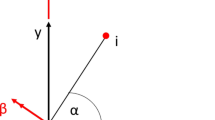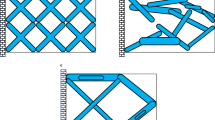Abstract
Polygonal finite elements have recently been widely implemented in topology optimization problems due to their great advantages such as highly accurate solutions and flexibility in mesh generation of arbitrary-shaped design domains. In this study, a polygonal topology optimization for Reissner–Mindlin (R–M) plate with minimizing the compliance under a volume constraint is proposed. In order to avoid the critical transverse shear locking phenomenon arising in the R–M plate theory, a simple and efficient locking-free polygonal R–M plate element (PRMn) based on the Timoshenko’s beam assumptions is applied to solve the R–M plate topology optimization problems. In our proposed method, we use the solid isotropic material with penalization model, the standard optimality criteria methods and density filter.


















Similar content being viewed by others
References
Bendsøe MP, Kikuchi N (1988) Generating optimal topologies in structural design using a homogenization method. Comput Methods Appl Mech Eng 71:197–224
Bendsøe MP, Sigmund O (2003) Topology optimization - theory, methods and applications, EUA. Springer, New York
Xie YM, Steven GP (1997) Evolutionary structural optimization. Springer, Berlin
Wang MY, Wang X, Guo D (2003) A level set method for structural topology optimization. Comput Methods Appl Mech Eng 192:227–246
Allaire G, Jouve F, Toader AM (2004) Structural optimization using sensitivity analysis and a level-set method. J Comput Phys 194(1):363–393
Bourdin B, Chambolle A (2003) Design-dependent loads in topology optimization, ESAIM: control. Optim Calc Var 9:19–48
Sigmund O, Maute K (2013) Topology optimization approaches: a comparative review. Struct Multidiscip Optim 48(6):1031–1055
Deaton JD, Grandhi R (2014) A survey of structural and multidisciplinary continuum topology optimization: post 2000. Struct Multidiscip Optim 49(1):1–38
Tenek LH, Hagiwara I (1992) Optimization of material distribution within isotropic and anisotropic plates using homogenization. Comput Methods Appl Mech Eng 109:155–167
Tenek LH, Hagiwara I (1994) Optimal rectangular plate and shallow shell topologies using thickness distribution or homogenization. Comput Methods Appl Mech Eng 115:111–124
Díaz AR, Lipton R, Soto CA (1995) A new formulation of the problem of optimum reinforcement of Reissner–Mindlin plates. Comput Methods Appl Mech Eng 123:121–139
Krog LA, Olhoff N (1999) Optimum topology and reinforcement design of disk and plate structures with multiple stiffness and eigenfrequency objectives. Comput Struct 72:535–563
Belblidia F, Lee JEB, Rechak S, Hinton E (2001) Topology optimization of plate structures using single- or three-layered artificial material model. Adv Eng Softw 32:159–168
Pedersen NL (2002) Topology optimization of laminated plates with prestress. Comput Struct 80:559–570
El-Sabbagh A, Akl W, Baz A (2008) Topology optimization of periodic Mindlin plates. Finite Elem Anal Des 44:439–449
Bathe KJ (1996) Finite element procedures. Prentice-Hall, Upper Saddle River
Zienkiewicz OC, Taylor RL (2000) The finite element method, vol. 2. Solid mechanics. 5. Butterworth Heinemann, Oxford
Hughes TJR, Cohen M, Haroun M (1978) Reduced and selective integration techniques in finite element analysis of plates. Nucl Eng Des 46:203–222
Boroomand B, Barekatein AR (2009) On topology optimization of linear and nonlinear plate problems. Struct Multidiscip Optim 39:17–27
Hughes TJR, Cohen M (1978) The “heterosis” finite element for plate bending. Comput Struct 9:445–450
Long CS, Loveday PW, Groenwold AA (2009) Effects of finite element formulation on optimal plate and shell structural topologies. Finite Elem Anal Des 45:817–825
Batoz J-L, Tahar MB (1982) Evaluation of a new quadrilateral thin plate bending element. Int J Numer Meth Eng 18:1655–1677
Dvorkin E, Bathe K-J (1984) A continuum mechanics based four node shell element for general nonlinear analysis. Eng Comput 1:77–88
Bathe K-J, Dvorkin EN (1985) A four-node plate bending element based on Mindlin/Reissner plate theory and a mixed interpolation. Int J Numer Meth Eng 21:367–383
Ye HL, Wang WW, Chen N, Sui YK (2016) Plate/shell topological optimization subjected to linear buckling constraints by adopting composite exponential filtering function. Acta Mech Sin 32(4):649–658
Tessler A, Hughes TJR (1985) A three-node Mindlin plate element with improved transverse shear. Comput Methods Appl Mech Eng 50:71–101
Soh AK, Long ZF, Cen S (1999) A new nine DOF triangular element for analysis of thick and thin plates. Comput Mech 24(5):408–417
Bletzinger KU, Bischoff M, Ramm E (2000) A unified approach for shear-locking-free triangular and rectangular shell finite elements. Comput Struct 75:321–334
Lee PS, Bathe K-J (2004) Development of MITC isotropic triangular shell finite elements. Comput Struct 82(11–12):945–962
Nguyen-Hoang S, Phung-Van P, Natarajan S, Kim H-G (2016) A combined scheme of edge-based and node-based smoothed finite element methods for Reissner–Mindlin flat shells. Eng Comput 32:267–284
Nguyen-Hoang S, Sohn D, Kim H-G (2017) A new polyhedral element for the analysis of hexahedral-dominant finite element models and its application to nonlinear solid mechanics problems. Comput Methods Appl Mech Eng 324:248–277
Nguyen SH, Kim H-G (2019) Level set based shape optimization using trimmed hexahedral meshes. Comput Methods Appl Mech Eng 345:555–583
Nguyen SH, Kim H-G (2020) Stress-constrained shape and topology optimization with the level set method using trimmed hexahedral meshes. Comput Methods Appl Mech Eng. https://doi.org/10.1016/j.cma.2020.113061
Nguyen-Xuan H, Nguyen-Hoang S, Rabczuk T, Hackl K (2017) A polytree-based adaptive approach to limit analysis of cracked structures. Comput Methods Appl Mech Eng 313:1006–1039
Nguyen-Xuan H (2017) A polygonal finite element method for plate analysis. Comput Struct 188:45–62
Nguyen NV, Nguyen HX, Phan D-H, Nguyen-Xuan H (2017) A polygonal finite element method for laminated composite plates. Int J Mech Sci 133:863–882
Nguyen NV, Nguyen HX, Lee S, Nguyen-Xuan H (2018) Geometrically nonlinear polygonal finite element analysis of functionally graded porous plates. Adv Eng Softw 126:110–126
Bruns TE, Tortorelli DA (2001) Topology optimization of non-linear elastic structures and compliant mechanisms. Comput Methods Appl Mech Eng 190(2–27):3443–3459
Liu GR, Quek SS (2002) The finite element method: a practical course. Butterworth Heinemann, Oxford
Floater MS, Gillette A, Sukumar N (2014) Gradient bounds for Wachspress coordinates on polytopes. SIAM Jf Numer Anal 52(1):515–532
Floater MS (2003) Mean value coordinates. Comput Aided Geom Des 20:19–27
Sukumar N, Moran B, Belytschko T (1998) The natural element method in solid mechanics. Int J Numer Meth Eng 43(5):839–887
Sigmund O (1997) On the design of compliant mechanisms using topology optimization. Mech Struct Mach 25(4):493–524
Andreassen E, Clausen A, Schevenels M, Lazarov BS, Sigmund O (2011) Efficient topology optimization in MATLAB using 88 lines of code. Struct Multidiscip Optim 43(1):1–16
Talischi C, Paulino GH, Pereira A, Menezes IFM (2012) PolyTop: a Matlab implementation of a general topology optimization framework using unstructured polygonal finite element meshes. Struct Multidiscip Optim 45(3):329–357
Author information
Authors and Affiliations
Corresponding author
Additional information
Publisher's Note
Springer Nature remains neutral with regard to jurisdictional claims in published maps and institutional affiliations.
Rights and permissions
About this article
Cite this article
Pham, QH., Phan, DH. Polygonal topology optimization for Reissner–Mindlin plates. Engineering with Computers 38, 141–154 (2022). https://doi.org/10.1007/s00366-020-01047-2
Received:
Accepted:
Published:
Issue Date:
DOI: https://doi.org/10.1007/s00366-020-01047-2




